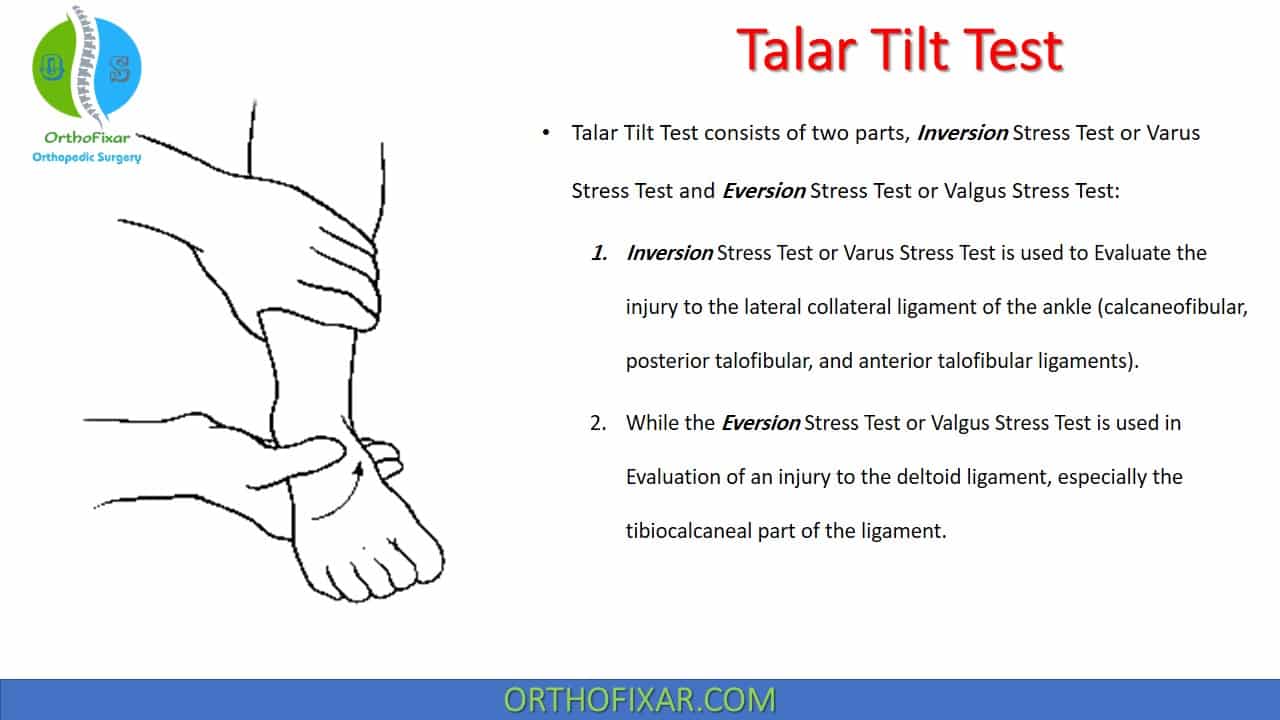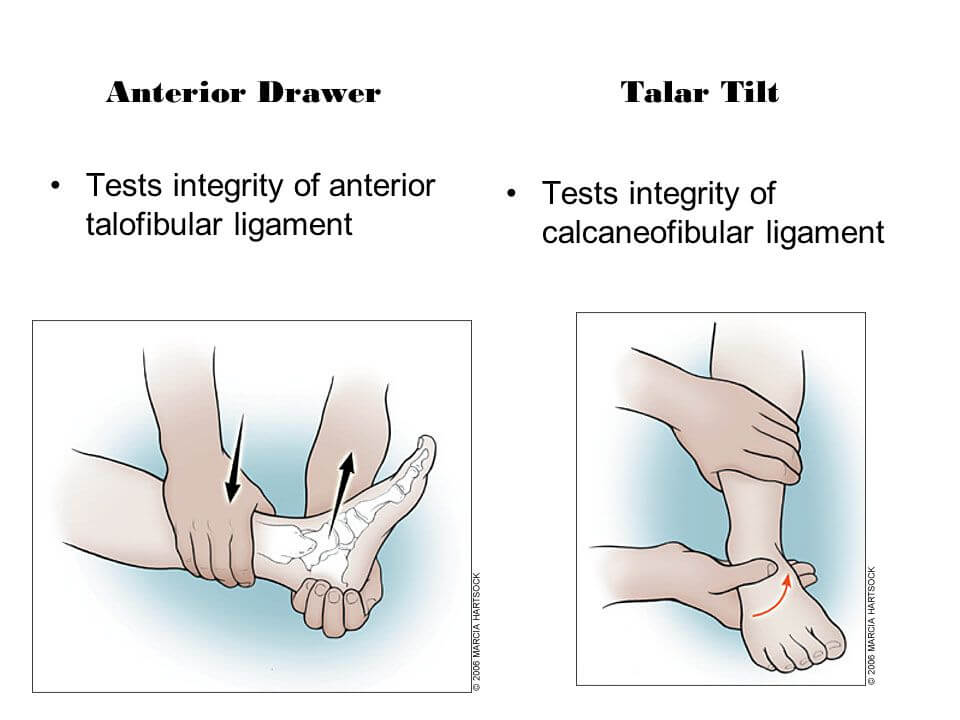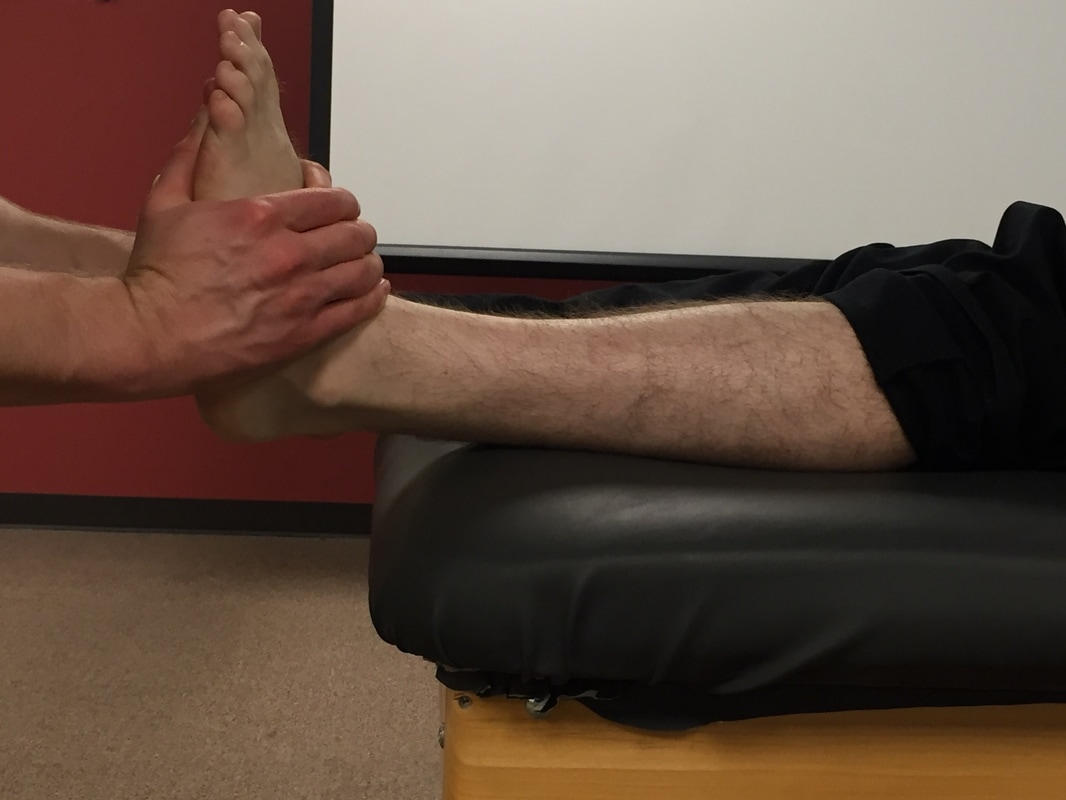
Inversion talar tilt test YouTube
The talar tilt test also assesses the lateral ankle ligaments for laxity, specifically calcaneofibular ligamentous laxity. The test is performed by stabilizing the distal leg in a neutral position while the examiner inverts the ankle. The degree of inversion is compared with the uninjured ankle. Both the talar tilt test and anterior drawer test.

Ankle Testing Eversion Talar Tilt test YouTube
Talar Tilt Test- tests the Calcaneofibular Ligament;. Trattnig S, Vécsei V. Diagnosis of lateral ankle ligament injuries: comparison between talar tilt, MRI and operative findings in 112 athletes. Acta Orthopaedica Scandinavica. 1997 Jan 1;68(3):286-90. ↑ 28.0 28.1 Encarnacion T. Ankle sprain. UConn Musculoskeletal Institute.

Figure 2 from Update on acute ankle sprains. Semantic Scholar
The test is positive if, when compared with the opposite ankle, the talar tilt is 10°s or more. A 20° talar tilt indicates a positive test, regardless of comparison with the opposite ankle. From: talar tilt test in The Oxford Dictionary of Sports Science & Medicine ». Subjects: Medicine and health — Clinical Medicine.

Inversion Talar Tilt test YouTube
Talar tilt test. excessive ankle inversion (> 15 degrees) compared to contralateral side indicated injury to ATFL and CFL. Imaging. Radiographs. indications for radiographs with an ankle injury include (Ottawa ankle rules) inability to bear weight. medial or lateral malleolus point tenderness.

Talar Tilt Test Lateral Ankle Sprain Pilates Therapy
INTRODUCTION. Ankle injuries are among the most common problems presenting to primary care offices and emergency departments [ 1-3 ]. Patients with ankle sprains (stretching, partial rupture, or complete rupture of at least one ligament) constitute a large percentage of these injuries. The epidemiology, presentation, and evaluation of common.

Talar Tilt Test YouTube
Talar Tilt Special Test: PROCEDURE 1: the patient lies in the supine or side lying position with the foot relaxed. the foot is held in the anatomic (90°) position, which brings the calcaneofibular ligament perpendicular to the long axis of the talus. talus is then tilted from side to side into adduction and abduction.

Talar tilt test for calcaneofibular ligament involvement. Download Scientific Diagram
The Talar Tilt Test is a common orthopedic test to be performed after an inversion trauma in order to assess the lateral ankle ligaments. It assesses the lateral ligaments of the ankle in three different positions. This way, the anterior talofibular ligament, the calcaneofibular ligament as well as the posterior talofibular ligament can be.

Talar Tilt Test YouTube
Talar Tilt. The Talar Tilt test, also known as the inversion stress test or varus stress test, assesses for instability of the lateral ankle ligaments* Sit the patient on a chair; With one hand, passively dorsiflex the ankle to stabilise the talar joint in the anterior-posterior direction; With the other hand, grasps the calcaneus and invert.

Talar Tilt Test OrthoFixar 2023
talar tilt test. angle formed by tibial plafond & talar dome is measured as inversion force is applied to hindfoot (5 deg is normal for most ankles) useful for evaluation of combined injury of both ATFL and CFL ligament. Imaging. talar tilt radiographs. ankle arthrograms.

The Talar Tilt Test Lateral Ankle Sprain YouTube
Enroll in our online course: http://bit.ly/PTMSK DOWNLOAD OUR APP:📱 iPhone/iPad: https://goo.gl/eUuF7w🤖 Android: https://goo.gl/3NKzJX GET OUR ASSESSMENT B.

Ankle Joint Medial Talar Tilt Stress Test(Inversion Test) YouTube
Subsequently, a rotational stress test to the talocrural joint is applied in the form of a talar tilt test. With the ankle in neutral position, the distal tibia and fibula are stabilized while the opposite hand provides a medial rotational force to stress the lateral portion of the joint (Figure 3). The mobilizing hand grasps the calcaneus, but.

TALAR TILT TEST YouTube
Inversion stress test (medial talar tilt stress test) The earliest reference of the Inversion stress test by Leonard 42 in 1949 reported that with "the foot at an angle of 90 degrees with the leg, the calcaneofibular ligament is perpendicular and the anterior talofibular ligament is parallel to the long axis of the talus. Therefore, inversion.

Stress Tests for Ankle Ligaments Epomedicine
Talar Tilt. Purpose: To test for injury to the lateral ligaments of the ankle. Test Position: Supine or sitting. Performing the Test: The examiner stabilizes the distal leg in a neutral position and inverts the ankle. The examiner then determines how much inversion is present. The amount present is graded on a 4 point scale of 0-3, with 0 being.

Talar Tilt Test YouTube
The talar tilt test cannot evaluate the specific pathology of lateral ankle ligaments, but it was reliable in indicating complete double-ligament ruptures (anterior talofibular and calcaneo-fibular ligaments), when talar tilt was 15" or more than on the uninjured side. Sensitivity 67, Specificity 75, LR+ 2.7, LR- 0.44..

Talar Tilt
Talar tilt test. It is also known as the inversion stress test and it stresses the calcaneo-fibular ligament, Procedure: The patient is positioned in sitting or supine lying with the knee in full extension. The examiner stabilizes the distal leg with one hand while the other hand holds the heel with the ankle in neutral position.

Talar Tilt Test for the ankle calcaneofibular ligament positive or negative YouTube
Usage. Talar tilt is an important measurement in the assessment of ankle osteoarthritis. It is measured as part of the Kellgren and Lawrence classification of osteoarthritis, as modified for the ankle joint 1.It is also important in preoperative evaluation, as the management of ankle osteoarthritis by total ankle arthroplasty necessitates the correction of that tilt (typically a varus tilt) at.